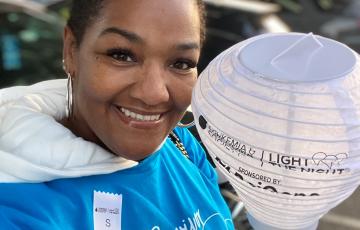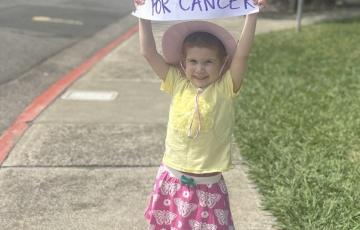Search Results

Chancez
Hey, my name is Chancez (ironically, I was blessed with many chances last year). I became a part of The Leukemia & Lymphoma Society (LLS) community last year and was provided financial support. I was also presented with love, care, and daily reminders of all the support that was available to me to get me through such a rough period in my life. A friend of mine suggested that I share my story to help others in our community, especially young adults who are in the same predicament I was once in.

Joseph
Feb 10, 2012 has forever changed our lives. Joseph was 6 years old and in his fifth month of kindergarten. Joe's journey actually began many months prior. Shortly after starting kindergarten there were ear infections, fevers, belly pain, joint swelling and bone pain. All this from a child who was always very healthy. Feb 10, 2012, the definitive diagnosis of pre-b cell acute lymphoblastic leukemia (ALL) was echoing through my head. Joe was admitted to the hospital immediately and taken to the pediatric hematology/oncology floor.

Virginia
I have been living with chronic myelogenous leukemia (CML) since August 6, 1997. The way I see it, I’m alive today because of The Leukemia & Lymphoma Society (LLS). The pill I take each day that keeps my leukemia in remission exists today much because of research grants awarded to Brian Druker, M.D., PhD., of Oregon Health & Science University.
Berenise
On October 22, 2013, as a senior in college, I was spontaneously diagnosed with acute myeloid leukemia (AML). I was immediately admitted into the hospital and began chemotherapy. The doctors basically said, "good luck”, as I received the routine treatment that has a survival rate of 25%. My life was flipped upside down in a matter of days. I went from planning what I was going to do after college, to deciding if I would want people at my funeral to wear black or be colorful. I didn't know whether to cry, scream, or be angry.

Cindy
Our church choir had put on a big Easter program in 2002, lots of practices and multiple performances. After the fact, several, including me, came down with an upper respiratory infection. All my friends got better, but I didn’t. Then I started having low energy to the point that I couldn’t do my daily workouts. Next came the appearance of big, ugly bruises on my legs. At that point, I thought I was anemic. When I called to get a doctor’s appointment, the only opening was with his nurse practitioner.

Towanna
I am Towanna, and I am a lymphoma survivor! I have been in remission for 17 years and counting.

Avery
I am writing as a parent of a cancer survivor. My daughter, Avery Smith, who is now 8 years old, was diagnosed at age 3½ with leukemia. In 2016, our then 3-year-old daughter Avery was complaining of muscle aches, backaches, and for a solid week was running a pretty high fever. We took her to the doctor, and after a few visits, they weren’t really sure what was going on. After some bloodwork, our pediatrician called us and said Avery had some very concerning numbers.

Siri
Siri is the most resilient, loving, inspiring, authentic, and brilliant woman I have ever met. She lives each day to the fullest and is filled with gratitude for all life and for every breath she takes. Her joy, light, and exuberance illuminate all around her. She is a two-time World Champion Triathlete, a top 10 global speaker, a best-selling author, a Tony Robbins keynote speaker at his worldwide events, saves horses from abuse, and so much more. Her life's mission is to help others. Here's a very condensed version of her story.

Kenya
I was diagnosed with two blood cancers — multiple myeloma (MM) and chronic myelomonocytic leukemia (CMML).
Cancer entered my life at five years old when I lost my father to pancreatic cancer. Then again, when my oldest sister was diagnosed with breast cancer, she is now nine years cancer-free. Then again, when my mother was diagnosed with breast cancer. Sadly, we lost my mother in May 2019 to breast cancer
Dorothy
In the fall of 2002, I had a missed call and a “call me when you’re out of class” text from my Dad. I was a sophomore at the University of Georgia when I heard, “Honey, I have cancer. Waldenstrom’s macroglobulinemia (WM).” So, I took a deep breath and asked, “Okay, so what’s next? Surgery? Radiation? Chemo?” “Nothing, we wait until it gets bad enough for treatment.”

Hadley
My granddaughter Hadley was three years old when she suddenly started limping in pain and was unable to bear weight on her right leg. Forty-eight hours and three medical appointments later, her bloodwork showed acute lymphocytic leukemia (ALL). It was a nightmare that came out of nowhere.
Imaging Tests
Imaging or radiology tests pass different forms of energy (x-rays, sound waves, radioactive particles or magnetic fields) through your body, creating pictures of the chest, abdomen, head, neck and other parts of the body.
Choosing a Blood Cancer Specialist
Hematologists specialize in internal medicine with a subspecialty in hematology, the study of diseases of the blood. A “hematologist-oncologist” is a doctor who specializes in treating people with blood cancers. Pediatric hematologist-oncologists treat infants, children, and adolescents with blood cancers. Blood cancers are uncommon diseases, so it can be to your advantage to be treated by a doctor specially trained to focus on treating patients with blood cancers.
Children and End of Life
Children facing end-of-life have specific needs and concerns to consider. It's important to approach them in a spirit of honesty. However, honesty doesn't mean overwhelming them with information and details that can be frightening. Honesty means honesty of feeling. Information needs to be screened and made appropriate for their needs.
Treatment
On average, individuals with essential thrombocythemia (ET) have a normal life expectancy if they are properly monitored and treated. It's important that your doctor is experienced in treating myeloproliferative neoplasms (MPNs) or works in consultation with a hematologist oncologist who has experience treating MPN patients.
Jarvis
In the fall of 2019, life was very active for me and my 4-year-old son Jarvis. I was busy working 2-3 jobs, and Jarvis was busy just being a kid. Almost every day after school we would go to the park so he could run around and play. He was even starting to get interested in bikes and wanting to learn to ride when he started to mention his feet were hurting.
Brent
My nephew Brent Terence was a perfectly healthy 17-year-old young man, active in school, up-to-date on his routine check-ups, and had normal labs. But until the end of July 2022, Terence showed signs of extreme fatigue, confusion, loss of memory, hallucination, and an inability to keep his eyes open and walk straight. So his parents, Brenda and Tristan, decided to take him to the ER. Multiple blood tests and X-rays were done, but they couldn’t figure it out.

Jonathan
I was diagnosed with B-cell acute lymphoblastic leukemia (ALL) on July 26, 2019, and even without the involvement of a pandemic, I imagine that’s reason enough to believe that to me 2018 seems like a lifetime ago. Still, I can remember it well enough: A wide-eyed younger version of me arrived at college orientation, somehow simultaneously thrilled to begin a new chapter of his life and paralyzingly terrified of the imminent unknown.

Jennifer
On New Year's Day 2012, I was diagnosed with acute myeloid leukemia (AML). I watched the ball drop in the ICU with a nurse assigned to me. They heard my mom being asked if I needed to be resuscitated, so they proceeded with that and then to hear her respond to do everything you can for her. The seriousness of that is very overwhelming.

Austin
Four were spoken that day. Four crushing, breathtaking words, “Your son has cancer.” My world, my life, and my dreams for my son’s future suddenly halted while the rest of the world kept going on around us on May 14, 2011. Only days before, I was deciding what theme to have for his third birthday party and what outfit he would wear for his pictures. Days later, my husband and I were signing consents for the specific protocol of poison that would be pumped into Austin and having to digest the laundry list of possible side effects.

Aryan
Hello, my name is Aryan. I am 13 years old. I was almost five years old when I first got diagnosed with cancer. It started as a normal summer like always, and we were planning to go somewhere. My dad was always traveling because of work, so it was just me and my mom. I would mostly spend time at my grandparents’ house because I could play games with them. One day my dad saw a bump on the back of my head, and our pediatrician told us that it was a lymph node. My pediatric doctor told my parents that it's normal, part of recovery from a fever or cough and to monitor it.